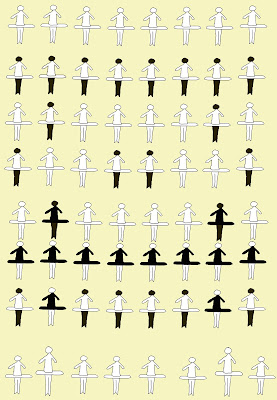(18a) Coloured people in ballet
An example is the all-male version of Tchaikovsky's Swan Lake. All swans are male (while female according to tradition) and there is love between the Prince and the main male swan. Although the public knows many dancers are gay, the most important dance houses didn't show this because one assumed the public would not like it (and not to draw attention to themselves as can be understand when society is not very tolerable). However, it was not the public that didn't like it because the ballet became an instant success when it was first shown at Saddler's Wells in Islington, London. But I read ones that the Royal Opera House in Covent Garden only agreed to perform it after they noticed the public loved it (correct me if I am wrong on this). And thus I think mainly the established performance houses, directors and choreographers who fear loosing audiences and thus income if showing something controversial together with performers who want fewer competition amongst themselves stop more colours and other changes are involved.
In addition, my experience with e.g. black friends is that many look down on ballet as a "white" dance for white people who naturally can't dance and thus need rules, instead of saying it is a different dance form than their own. I understand why they are saying this as they want to have their own dance being recognised and thus also the significance of their own culture. Still, I think everyone should embrace every art form (and other things) without always feeling the necessity it should all become integrated and the same.
And when one thinks that, as a coloured person one has less chances in an established house, then why not move to a lesser one or even found ones own company and become so good established houses loose audiences and will be forced to accept changes, including people from other colours. Many white people do this (e.g. when their choreography is not liked by the big companies), thus people from other colours could do this too instead of always wanting to be integrated in organisations they claim don't really like them or they don't like.
But I agree when he says that many choreographers want to keep symmetry because it can be beautiful although I think it is mainly to prevent people look to the individual persons in the corps and thus less to the main dancers. Still, symmetry can also be reached with the use of different colours and sizes as I will show via the examples in the figure and thus reduce the focus on individuals within the group.
 |
| Possibilities of use of different colours in the corps de ballet while the final row show how different lengths can be used. Of course, artists are even better in doing this if they are open for it. |


Comments